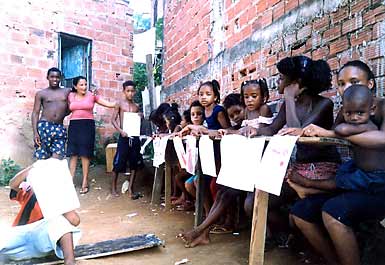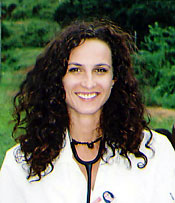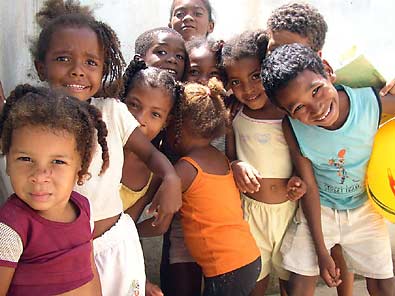UC Berkeley Web Feature
 |
Children and teacher and what remains of their school in Salvador da Bahia, Brazil in the aftermath of heavy rains (Krisztina Szabo photos) |
Stint in Brazil results in progress against a public health threat and heartbreak at a shantytown school
SALVADOR DA BAHIA, BRAZIL – Over the past several months, I have been in Salvador, Brazil collaborating on an infectious diseases research project and fulfilling my fieldwork requirement for my Infectious Disease Masters in Public Health Program at the UC Berkeley School of Public Health.
 Krisztina Szabo |
Tonight, as I write I am fortunate to be able to watch one of the amazing Brazilian sunsets overlooking the bay Baia de Todos os Santos from my apartment window in the city of Salvador da Bahia. The gigantic fluffy clouds reflect the sun's rays in hundred ways in a huge mango-orange swirl. Yes, it's a much better view than the view from my apartment window in Berkeley overlooking Foster's Freeze on University Ave. It's not that I don't like the smell of hotdogs at the corner, coming home from school on Bus #51 at 10 p.m.; I just prefer to see the ocean in Brazil. I feel very lucky every day to live and work in this close-to-paradise place for three months. Salvador, once a capital of Brazil and today the center of Afro-Brazilian culture, will mesmerize you with the rhythms of afroxé, the dance-martial art capoeira, and the spirituality of Candomblé, the Afro-Brazilian religion. The only thing bothering me now, though, is my fever and the muscle aches from a mild case of dengue – a mosquito-borne illness endemic in Brazil and in tropical environments.
How did I get it?
Well, certainly not from my well-situated apartment at Laderia da Barra overlooking the bay. Most likely I got it in Pau da Lima, a shantytown or favela with over 12,000 residents where I work several times a week. What is a favela? It's an urban slum created by social inequality. Brazil went through a 350 percent increase in urban population in the last 30 years. One consequence of this urbanization is the favelas, which are found in all major cities of Brazil. More than 30 percent of the world's population live in shantytowns and subsist on less than $1 per day. One characteristic of a favela is that despite all its residents, it does not exist on any map. Pau da Lima does not exist because it's located outside of one's peripheral vision, down in a very steep valley with dense vegetation, narrow passages, mud, a huge number of stray dogs, open sewers, garbage, and rats. But most importantly, it is filled with the visible poor encountering visible diseases. It is also filled with spirited people, children playing on the fields with homemade toys, barefoot, but with huge smiles on their faces. It is also filled with volunteers, scientists, and doctors who work in this community with all their hearts. The faces of children and people are the faces of poverty that become part of you. Poverty stares at you in the face in Pau da Lima.
Open sewers, rats, and Leptospirosis
My work is a combined effort between the Oswaldo Cruz Foundation in Brazil with the Infectious Diseases and Social Inequalities program, UC Berkeley professor Lee Riley, and Cornell University professor Albert Ko. I came to work on a disease called Leptospirosis, a life-threatening bacterial infection transmitted through contact with urine from infected animals, mainly rats. It is one of the most common zoonotic (communicable from animals to humans) diseases in the world and in Brazil alone there are over 10,000 cases of Leptospirosis per year. It is a disease of poverty that can be easily treated with inexpensive antibiotics, but mortality remains high, about 15 percent due to delayed treatment. Consequences of delayed treatment are severe kidney and liver failure with pulmonary bleeding. Delayed treatment can also result from its diagnostic confusion with dengue, the disease I contracted after working in Pau da Lima. Pau da Lima with its open sewers and high number of rats, makes it an ideal location for the transmission of Leptospira because people live and work very close to open sewers with a very high number of rats in the community.
Due to problems with delayed treatment, we are studying if early diagnosis can improve disease outcome. The project team identified a new Leptospira protein called LigB that appears to serve as a sensitive target for antibody-based diagnosis. The team wishes to simplify the use of this antigen-detection method, apply it at community level, and see if early diagnosis will lead to early antibiotic intervention and prevent severe disease outcomes.
The Salvador team also identified risk factors for severe disease after infection, which can be due to differences in exposure levels to the organism, host factors, or the pathogenicity of the infecting Leptospira. When it rains in Salvador, it pours in Pau da Lima. When a person walks through rainwater or stands in a sewer contaminated by rat urine, Leptospira corkscrews through his skin, causing systemic disease. Preliminary studies have shown that living in close proximity to open sewers and sighting more than five rats in a previous week are significantly associated with severe disease because a person gets greater exposure. The first time I experienced rain in Pau da Lima while working, I was scared. Sewers flood and houses located at the bottom of the valley are flooded with sewage. The houses, which are located higher up often collapse from the mudslide.
We also hypothesize that naturally-acquired immunity develops after a previous infection, which reduces the risk of developing severe disease outcomes following re-infection. If a previous infection is found to be protective for subsequent disease, a possibility for the effectiveness of a vaccine can be demonstrated. I am analyzing epidemiological data collected over three years to look at the baseline prevalence and seroconversion of participants with Leptospira in a period in an open cohort study.
A school that transforms lives
My first visit on my first day of work at Pau da Lima, however, was not to collect data for the Leptospirosis project. I went out for a site visit with volunteers to an escolinha (small school) that collapsed due to heavy rains. They were going to design a new school and rebuild it. While at the destroyed school, I experienced one of the most memorable moments of my life. There, I met Nivaldina, the teacher of the collapsed escolinha. She is not a conventional teacher by any means. She finished the third grade and taught the children the alphabet, the numbers and read them the Bible for three years. She was telling me about it as we descended the clay steps to the escolinha in a narrow, muddy passage. Money for supplies and food came from the community and from volunteers. There was a need to teach at least 200 children but there was just not enough funding. This school is critical to the community, where there is high drug use and trafficking, and other criminal activities. The school had kept kids out of trouble and away from danger. About 40 kids per day, ages 1-7, stayed here with her every day. When I first stepped into the escolinha with only its walls remaining, the children's happy drawings were still on the wall. I walked out with tears in my eyes and I knew then that I would have a very hard, emotional, but rewarding experience working in Pau da Lima.
My mind was racing with questions. Why don't these children just go to another public school? Why is this school so important? The more I talked to Nivaldina, the simpler the answer became. Most children and their parents don't have the legal documentation required to attend a real school. They are too poor to have identification and in the eyes of the Brazilian government they simply do not exist.
I was trying to find a way to help when I met Simone Manigo
Truell, the vice president and founder of Levantamos, a
non-profit corporation located here in Salvador. It is
an organization for Afro-Brazilian-American human rights
whose main office is in Washington D.C. The organization
focuses on helping Afro-Brazilians by providing educational,
social and cultural opportunities. Meeting Simone was a
moment of promise. We met on a the beach sipping caipirinha,
the famous Brazilian drink, and making small talk when
we discovered that what drove us in life was very similar.
We talked about the escolinha in Pau da Lima and what it
would mean for the children if it could be rebuilt. Simone
embraced the project. Currently, Levantamos and its board
members are reviewing the final data in Washington D.C.
and will make a decision shortly regarding the rebuilding
the escolinha.
Why did I choose to do this public health project in
Brazil? My dream to help others began in a small village
in Hungary, tagging along with my mother, a nurse during
the hard times of a totalitarian government in the early
1980's. Working in the community there allowed
me to see the health needs of people ranging
from the very young to the very old, no matter where
they live. Brazil was my first opportunity to work in
South America. I was excited, hopeful and scared of the
unknown. I knew that this would be public health in action,
something you learn about in your textbooks but seldom
see in the U.S.
But the question that nags at me as my internship comes to an end in Brazil and Pau da Lima, is what will happen to the escolinha without a real financial and organizational structure? I came here with many questions and uncertainties in my mind about how much one can really help in this environment. I have learned that the escolinha and the work of Nivaldina are transforming the lives of many amid this cacophony of poverty. I know in my heart that I will come back to Pau da Lima and see the escolinha functioning once again.
In fact, I must come back and work again with my friends. To me this has been a formative moment: I want to live my life to work with those who are voiceless. In Pau da Lima, I had an opportunity to scratch the surface of my dream, and to become part of the lives of others and to learn from them. I realize that to truly understand the forces of poverty and disease, and to improve the health and well-being of thousands, one must work with others and change things little by little. What I don't know yet and must still learn is whether this can be done through science as a form of advocacy for social change.
 |

